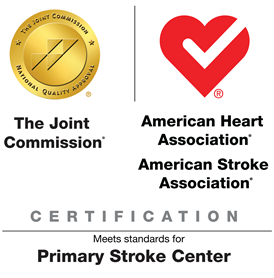Recognizing a Stroke
Stroke: Act F.A.S.T.
 Swimming, biking and running are just three of the many sports in which the winner has the fastest time. In other sports such as football, basketball or volleyball, the winners are determined after a set period of time. When it comes to having a stroke, the person who seeks treatment in the fastest time possible can be a winner in the game of life. That’s because the faster blood flow is restored to the brain, the lower the risk of disability or death.
Swimming, biking and running are just three of the many sports in which the winner has the fastest time. In other sports such as football, basketball or volleyball, the winners are determined after a set period of time. When it comes to having a stroke, the person who seeks treatment in the fastest time possible can be a winner in the game of life. That’s because the faster blood flow is restored to the brain, the lower the risk of disability or death.
A stroke, also known as a brain attack, occurs when blood flow to the brain is interrupted or blocked. When this happens, brain cells in the immediate area start to die because they do not get the oxygen and nutrients they need to function properly. Disabilities that can result from a stroke include paralysis, cognitive deficits, speech and emotional problems, pain and numbness. Approximately 87% of strokes are ischemic, which means they occur when a clot blocks a blood vessel or artery in the brain. The remaining percentage of strokes is hemorrhagic. These strokes are caused by a blood vessel that breaks and bleeds into the brain.
Symptoms of a stroke are easy to spot because they happen quickly. It is important to act F.A.S.T. in these situations because the most effective treatments for stroke are available only within the first three hours after symptoms start.
Look For the Following Signs of a Stroke:
- Face – Does one side of the person’s face droop when you ask them to smile?
- Arms – Does one arm drift downward when you ask the person to raise both arms?
- Speech – Does the person slur speech when asked to repeat a simple phrase?
- Time – Call 911 immediately if you see any of these signs.
If You or Someone You Know is Having a Stroke:
Be prepared to act promptly if there is sudden:
- Numbness in the arm, leg or face, especially if it is on one side of the body.
- Confusion, difficulty talking or problems understanding speech.
- Trouble seeing out of one or both eyes.
- Difficulty walking, dizziness, or loss of balance or coordination.
- Intense headache for no known reason.
It is important not to wait for symptoms to go away or worsen. Ischemic strokes can be treated with a clot-busting drug called tissue plasminogen activator, or t-PA. However, for the treatment to be effective, the stroke patient must get to a hospital within one hour, and be evaluated and receive the drug within three hours of the onset of stroke symptoms. A study by the National Institute of Neurological Disorders and Stroke found that some patients receiving t-PA within the three-hour window were at least 30 percent more likely to recover from a stroke after 90 days.
Risk factors that can increase the chances of having a stroke include high blood pressure, heart disease, smoking, diabetes, sedentary lifestyle and elevated cholesterol.
American Stroke Association
For more information about stroke warning signs, risk factors, prevention, and treatment, visit the American Stroke Association Web site at www.strokeassociation.org.
Need Help?
Learn about stroke care at Weiss.
